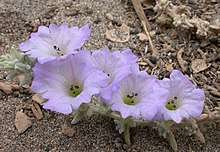Nolana
Nolana (Chilean bell flower) is a genus of hard annual or perennial plants in the nightshade family. The genus is mostly native to Chile and Peru. Species in this genus, especially N. paradoxa, serve as a model system for studies on flower color.[1][2]
| Nolana | |
|---|---|
 | |
| Nolana bombonensis | |
| Scientific classification | |
| Kingdom: | Plantae |
| Clade: | Tracheophytes |
| Clade: | Angiosperms |
| Clade: | Eudicots |
| Clade: | Asterids |
| Order: | Solanales |
| Family: | Solanaceae |
| Subfamily: | Solanoideae |
| Tribe: | Nolaneae |
| Genus: | Nolana L.f. |
| Species | |
|
See text | |
Classification
There are a number of synonyms for Nolana: Alibrexia, Aplocarya, Bargemontia, Dolia, Gubleria, Leloutrea, Neudorfia, Osteocarpus, Pachysolen, Periloba, Rayera, Sorema, Teganium, Tula, Velpeaulia, Walberia, and Zwingera.
Nolana is the only genus in the Solanaceae which has a fruit composed of mericarps, although its flower and other vegetative morphology is similar to other plants in this family. It seems to be most closely related to Lycium and Grabowskia.[3]
Selected species
- Nolana acuminata
- Nolana atriplicifolia
- Nolana crassulifolia
- Nolana galapagensis
- Nolana humifusa
- Nolana prostrata
- Nolana rupicola
- Nolana sedifolia
- Nolana tenella
- Nolana paradoxa
gollark: You do, in fact, need to convert booleans into other types when using them in some ways.
gollark: I think that's doable.
gollark: Hmm, maybe I should make potatOS automatically cast booleans to random numbers.
gollark: `pcall` returns `true`/`false` as its first return value.
gollark: You're pcalling it.
References
- Stavenga, D. G., van der Kooi, C.J. (2016) Coloration of the Chilean Bellflower, Nolana paradoxa, interpreted with a scattering and absorbing layer stack model Planta 243:171-181
- van der Kooi, C. J. et al. (2016). How to colour a flower: on the optical principles of flower coloration Proceedings of the Royal Society B: Biological Sciences: 283
- Dillon, M. O. (2005). The Solanaceae of the Lomas formations of coastal Peru and Chile. Monographs in Systematic Botany 131-56.
- Dillon, M. O. and J. Wen. Phylogenetic Systematics of Nolana (Solanaceae) and Biogeographic Implications for the Atacama and Peruvian Deserts.
| Wikimedia Commons has media related to Nolana. |
This article is issued from Wikipedia. The text is licensed under Creative Commons - Attribution - Sharealike. Additional terms may apply for the media files.